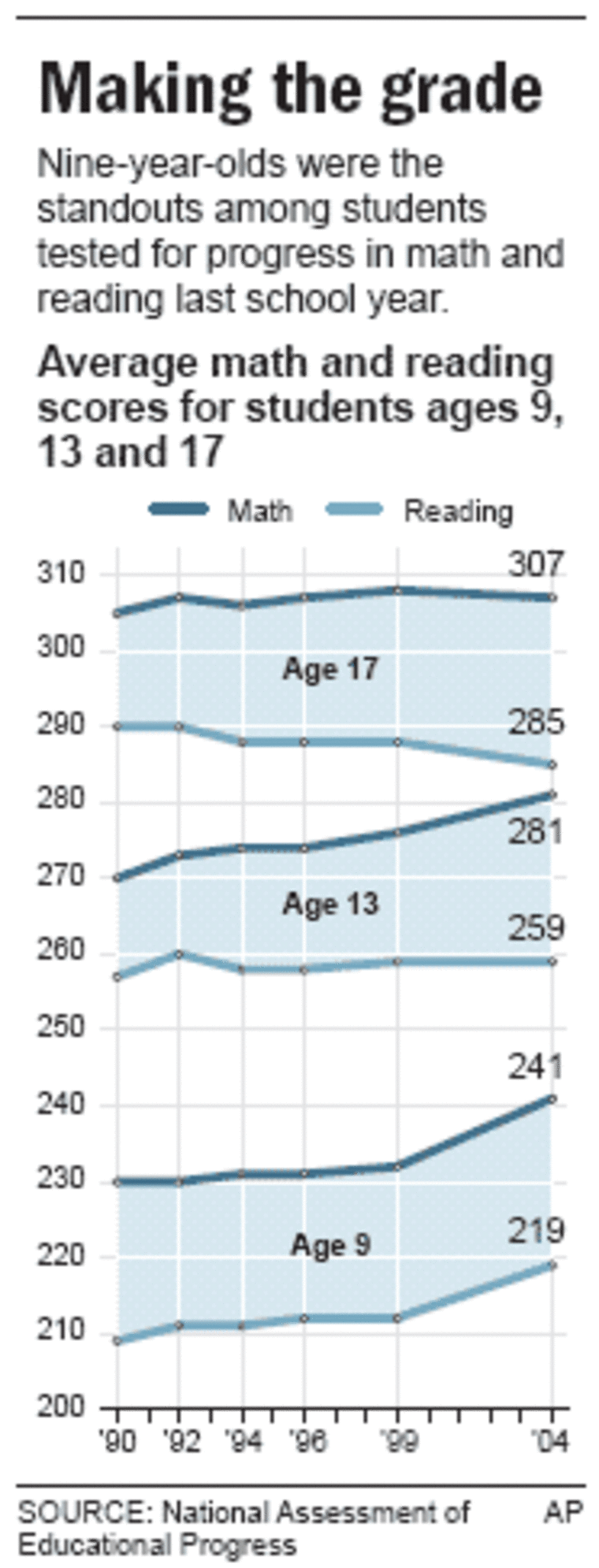The nation’s 9-year-olds last year posted their best scores in the building-block subjects of reading and math in more than three decades. Older students didn’t fare as well.
At the same time, achievement gaps between racial groups narrowed, according to results of the 2004 National Assessment of Educational Progress announced Thursday.
Education officials and advocates attributed the 9-year-olds’ performance to a recent emphasis on elementary schools and getting children reading as early as possible. They said the results also showed more attention must be paid to students in secondary schools.
“We need to go to work,” Education Secretary Margaret Spellings said in an interview.
Spellings also credited No Child Left Behind, the education law President Bush signed in January 2002 that mandates frequent testing of students to chart their progress in reading and math.
Bush takes credit
During an appearance Thursday at a black business convention in Indianapolis, Bush claimed some credit for narrowing the gap in test scores between black and white elementary school students.
To help high school students do better, Bush also has proposed providing early intervention for failing students and testing of all ninth-, 10th- and 11th-graders.
On last year’s National Assessment, sometimes known as the nation’s report card, 9-year-olds earned their highest scores since the tests were first given — reading in 1971 and math in 1973.
The exams are given periodically to 9-, 13- and 17-year-olds, most recently in 1999.
‘Persistence pays off’
On a scale of 0-500, the 9-year-olds scored 219 in reading 2004, compared with 212 in 1999 and 208 in 1971. In math, they scored 241 last year, 232 in 1999 and 219 in 1973.
The message is “that persistence pays off,” said Francie Alexander, a member of the National Assessment Governing Board, which oversees the test.

Results were mixed for 13-year-olds, and remained flat for 17-year-olds.
Thirteen-year-olds earned their highest math scores ever, but their reading scores were just a few points better than in 1971 and about the same as five years ago.
In math, their average scores went from 255 in 1973 to 276 in 1999, and climbed to a high of 281 in 2004. In reading, the trend was 255 in 1971, rising to 259 in 1999 and holding at that level in 2004.
Seventeen-year-olds continued a trend of flat scores in both subjects, although greater percentages reported taking advanced math, such as second-year algebra or calculus.
Their reading score of 285 was the same in 1971 and 2004, while it was 282 in 1999. Math scores increased from 304 in 1973 to 308 in 1999 before falling back to 307 in 2004.
Charles Smith, executive director of the assessment governing board, attributed that performance to the traditional slacking off by high school seniors. “The problem with senioritis is alive and well,” Smith told AP Radio.
Racial disparities narrow
Among the racial groups, most gaps in reading and math scores showed some narrowing. Every age group, except for Hispanic 13-year-olds, cut into the achievement gap with whites in comparison with the 1970s.
In reading, black and Hispanic students scored higher than in the early 1970s, with 9-year-olds in both groups posting their best scores yet, 200 and 205 points respectively.
In math, minority students scored higher than 30-plus years ago, with 9- and 13-year-olds in both groups earning their highest marks in the history of the exam. Among blacks, the scores were 224 and 262, respectively; among Hispanics, they were 230 and 265, respectively.
Only black and Hispanic 17-year-olds showed no improvement from five years earlier. All age groups, except for Hispanic 9-year-olds, have narrowed the achievement gap since the 1970s.
Teachers' group lauds states
Antonia Cortese, executive vice president of the American Federation of Teachers, said No Child Left Behind wasn’t completely responsible for the good results. She noted that many states had begun to focus on education long before Bush became president.
Rather, Cortese credited teachers, administrators and schools. “The bottom line is kids are doing better and the gap is closing and that is very promising,” she said.
Kati Haycock, director of the Education Trust, an advocate for poor and minority students, said the results put “to rest the notion that achievement gaps are inevitable. Expectations have increased, and students of color are rising to the challenge.”
Participation in the test is voluntary for schools and students. Some 28,000 students in public and private schools — 14,000 in each subject — took the exam during the 2003-2004 school year.
Thursday’s results were national only. State-by-state test results will be released in the fall.
